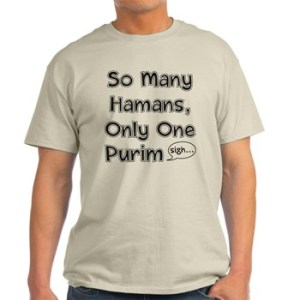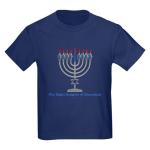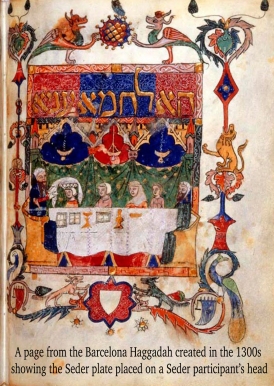
While most Jews participate in a seder, the customs around and during the seder differed in different parts of the world. Here are some novel ways the seder was celebrated in Europe, the Middle East and Asia. Many of these communities no longer exist today and some of these customs may no longer be practiced.
Passover Preparations:
Ethiopia- To symbolize a truly new beginning, in some Ethiopian families the matriarch would destroy all her earthenware dishes and make a new set for Passover and the rest of the year.
Yemen: The door to the house was kept open for the entire seder so everyone would be able to leave quickly when the Messiah came.
Morocco- Traditional Moroccan clothing, white kaftans with gold embroidery, and robes are worn during the seder. These are reminders of the clothing worn by the High Priest in the Temple in Jerusalem.
Egypt- Before the seder, unmarried young women hid behind a door to eat a hard boiled egg. The egg was a symbol of fertility suggesting a marriage in the near future.
The Seder Table
Hungary- While we set the table with our finest china and linen, in Hungary they went one step further and placed all their gold and silver jewelry on the table, in remembrance of the gold and silver the Jews received from the Egyptians before they left.
The Seder Plate

Yemen- There was no separate seder plate. The entire table was the seder plate. Each participant was given a serving of all the foods on the plate, except for the greens, which were spread on the table.
Tunisia- They also did not use a seder plate. Instead, the symbolic foods were placed in a reed basket which rested on the table. Before saying the beginning paragraphs about the poor bread, Ha Lachma Anya, the mother would circle the head of each participant with the basket proclaiming the haste in which the Jews left Egypt. The participants would answer that while yesterday they were slaves, today they are free, and that this year they are here, but next year they will be in Jerusalem. The basket was thought to symbolize baby Moses and the woman carrying it of his Mother Yocheved and sister Miriam.
Spain- It seems that in Spain before the opening paragraph about the poor bread, the seder leader would walk around the table and tap each participant’s head with the seder plate. In some cases, only the children’s heads were tapped.
Morocco- With much fanfare and singing, the seder plate was brought into the room. The seder leader passed it over the heads of all participants, who sang, “Once we were slaves, now we are free.” After he placed the seder plate on the table, he once again picked up the plate, this time, however, moving it over the center of the table to honor those no longer in the land of the living.
Barcelona, Morocco and Gibraltar – The custom in some families was that after reciting “In Haste We left Egypt,” three times, the seder leader walked around the table tapping each person’s head with the seder plate three times, each time a bit harder. This was meant to remind participants of slavery and hard times Jews suffered in Egypt.
Karpas- The Vegetable that is Dipped
Ashkenazim- European Jews and their descendants generally dip the vegetables into salt water, which symbolizes the tears shed by our ancestors in Egypt. Sephardim- those whose ancestors were from Spain and Portugal, usually use vinegar as the dipping liquid. Some, however, dip the vegetables into charoset.
Afikoman– Taking the Split Middle Matzah
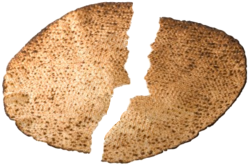 In many Sephardic communities, the afikoman is wrapped in a large napkin and given to a child to sling over his shoulder as if he were a Jew leaving Egypt. (In Egypt, everyone was given a chance to hold the afikoman.) Then the seder leader asked the afikoman holder two questions: wherever you from and where are you going? The person holding the afikoman would answer that he was from Egypt and was going to Jerusalem.
In many Sephardic communities, the afikoman is wrapped in a large napkin and given to a child to sling over his shoulder as if he were a Jew leaving Egypt. (In Egypt, everyone was given a chance to hold the afikoman.) Then the seder leader asked the afikoman holder two questions: wherever you from and where are you going? The person holding the afikoman would answer that he was from Egypt and was going to Jerusalem.
Iraq and Kurdistan- The child holding the afikoman would go outside and knock on the door. After he was invited inside, he was asked the two questions. After answering them, he would say the Four Questions. Another tradition involved wrapping the Afikoman in a scarf, and tying it on the backs of the children like a beggar’s bundle. The children then went outside , knocked on the door and pretended they were traveling from Egypt to Jerusalem.
Turkey and Greece- It was the seder leader who left the room and returned holding a walking stick in one hand and the wrapped matzah slung over his shoulder. He too would answer the two questions asked of him.
Yemen- The seder leader answered the two questions and then told the group all about his life as a slave in Egypt and the miracles he witnessed when he left Egypt. Another tradition practiced involved one member of the family taking the afikoman, tying it in a scarf, placing it on his shoulder and walking around the house. When the others asked him why he was doing this, he replied that that was what our ancestors did when they left Egypt.
Some German Jews, before reciting the Haggadah, also had the custom to walk around the room with the wrapped afikoman on their shoulders. In southern Germany, the seder leader would take the afikoman which was wrapped in a white matzoh cover , sling it over over his shoulder and explain that this was how the Jews left Egypt.
Hungary- The seder leader wrapped the afikoman in a scarf, placed on his shoulders and then said, “let’s go, let’s go.”
Mumbai, India- The seder leader took a wooden cane in his hand and walked around the table telling everyone about his life as a slave and the miracles he saw.
Iran and Iraq- The youngest male child took the afikoman, put it in a bag on his shoulder, and walked around the seder table. All the guests got up and followed the child, who was playing the role of Moses taking the Jews out of Egypt.
Kurdistan- Kurdish Jews had a tradition of tying the wedding contract to the arm of the bride. From this, the practice developed of tying the Afikoman to the arm of the son they wanted to marry off during the coming year. After the Afikoman was tied to the selected son, seder participants expressed their hope that just as the afikoman was bound to his hand, so may he bind the marriage contract to the arm of his bride.
The Ten Plagues
Sephardim- While Ashkenazim dip their pinkies into their glass of wine and spill out 10 drops to commerate the ten plagues, Sephardim treat the plagues like something bad. In Iraq, Jews spread an additional tablecloth over the table before reciting the plagues to protect the food and those seated around the table from the plagues.
Turkey and Balkans- Some families did not look at the spilled wine from the cup, so they would not be contaminated. In other families, only the seder leader spilled out the wine and washed his hands afterwards as a symbolic cleaning.
Cochin, India- Only the seder leader spilled out the wine from a special wine cup, located close to the seder leader, called the Pharoah’s cup. Afterwards, he also washed his hands.
Aden, Yemen- The 10 drops of wine were poured from one glass into another and then that glass was disposed of in the garden, so the plagues would be transferred to their enemies.
Iraq- Wine drops were poured into a Ziplock bag, which was removed from the house and thrown away.
Egypt- The wine drops were poured into a bowl from a large wine glass with some water added. However, this was all done under the table. No one looked at it as it was considered bad luck. Then the wine mixture was poured into the toilet.
Greece- As each plague was recited, Greek jews poured vinegar into a bowl next to them.
Libya- The spilled wine was considered a messenger of good luck. The single girls in the family would wash their feet in the “plague waters” in the basin, hoping that the “plague” of being single would end in the coming year.
Dayenu

Persia- Holding bunches of celery, chives, leeks, or scallions, seder participants lightly beat each other on the shoulders.
Iran, Afghanistan, and Iraq- Each seder participant had a turn as the Egyptian taskmaster who would beat the person next to him with a vegetable “whip.” While the whipping was going on, the other guests would wish each other a green, fruitful year and lucky year.
Italy- The whip was made of long stemmed green onions. While singing the chorus of Dayenu, everyone would pick up an onion and whip the wrist of the person next to him.
Charoset- the “Brick” concoction
Gibraltar- The Jews of Gibraltar mixed actual brick dust into the Charoset.
Main Course
Aden, Yemen- All types of eggs and egg dishes were the main course.
Morocco- Lamb and truffles were often the main dish.
Elijah’s Cup
Morocco- Instead of a cup of wine for Elijah, which most Sephardim don’t provide, the family would prepare a special chair with cushions and ornaments for him to sit on when he arrived.
Germany- When the words “Pour out your anger,” were reached in the Haggadah, someone in costume, imitating the arrival of Elijah, would enter the home to announce the coming of the Messiah.
End of Seder
Syria, Morocco, Iraq, Kurdistan, Djerba, and the Caucasus- At the end of the seder men would quickly leave the house with a stick and a bundle on their shoulders and say that this is how their ancestors left Egypt.
Afghanistan, Iran and Bukhara- Small pieces of the afikoman were kept as talismans to protect against the evil eye.
Syria, Iraq, Libya and Tunisia- Pieces of the afikoman would be taken along on trips to protect against storms at sea and dangers on the road.
Kurdistan- Jews would hide pieces of the afikoman in their rice, flour and salt to ensure they would have enough of these in the upcoming year.
North Africa and Greece- Jews would keep a piece of the Afikoman in their pockets and houses for good fortune and plenty throughout the year.
Poland- A piece of the Afikoman would be hung on the wall as a good luck omen.
Yes, we Jews practice many different seder customs. But these are all part of the glorious Jewish heritage.
Enjoy!
HAPPY PASSOVER!

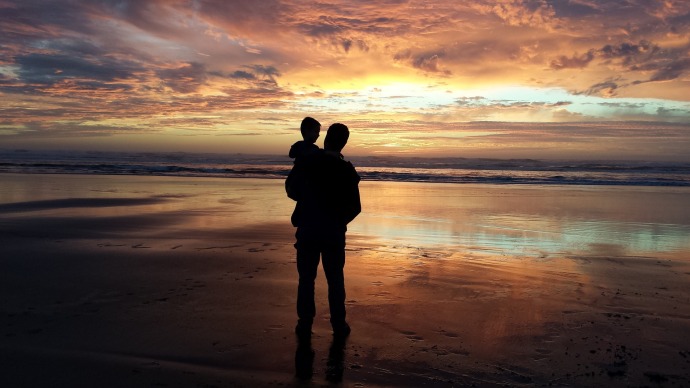




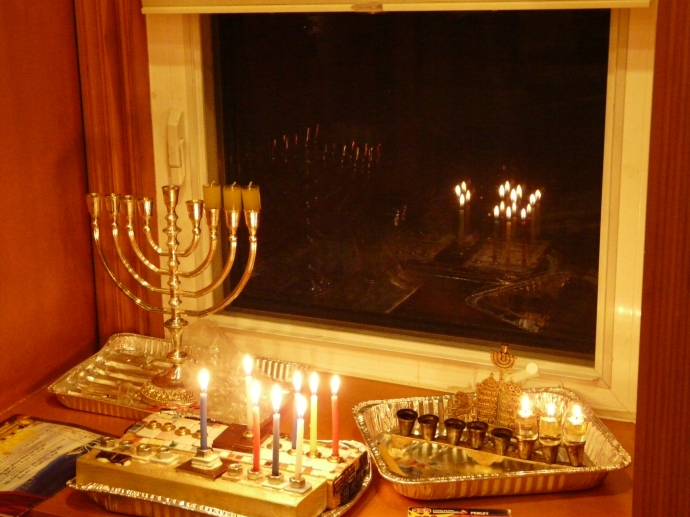

 In the final hours before the the majority of the electorate goes to the polls to elect the 45th President of the United States, I thought a final analysis would be in order.
In the final hours before the the majority of the electorate goes to the polls to elect the 45th President of the United States, I thought a final analysis would be in order.






